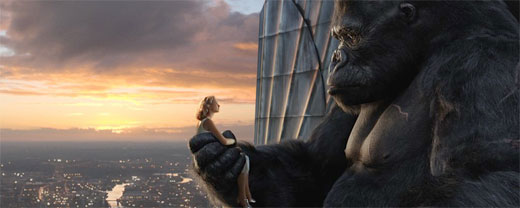
King Kong
By now everyone knows the story: Peter Jackson, as a young New Zealand boy, sees 1933’s King Kong on television, and from that moment is driven to become a filmmaker. I myself have never seen the entirety of the original Kong (though it’s high on my Netflix queue at the moment), so I was going into the theater with the same fresh eyes Peter Jackson had all those years ago. The fact that I didn’t come out quite as inspired as Jackson cannot dampen my sincere enjoyment of this amazing spectacle of moviemaking.
Unlike many modern remakes, King Kong is iconic enough that even if you haven’t seen the original picture. Even if you don’t know how the story begins, (Movie producer/director Carl Denham takes an intrepid crew to a mysterious island where fresh-faced Ann Darrow is sacrificed to the mighty ape), you know how the story ends (the beast is brought back to New York by Denham—in a spectacle only Broadway could play host to—and everything goes massively wrong). Knowing the story and seeing it unfold are two completely different experiences.
With King Kong, Peter Jackson moves ever closer to cementing his status as the rightful heir to Steven Spielberg’s popcorn throne. This is a massive movie—a grand adventure in old-fashioned movie making with the modern twist of dazzling special effects and stunning digital characters. Kong is filled with thousands of effects shots, but nothing is more elegantly created than the big ape himself. The original 800-pound gorilla is the most believable digital character in history, topping Jackson’s own Gollum (as well as other recent stars like Yoda and Aslan). On top of that, the movie features the best dinosaurs I’ve ever seen on film (sorry Jurassic Park), and a marvelous, vivid recreation of 1933 New York.
With all the whiz-bang effects and the thrill of the unrelenting set-pieces staged on Skull Island, lost in the shuffle are great performances by a huge cast including Jack Black as the conniving, careless Denham, Billy Elliott’s Jamie Bell as young shipmate Jimmy, Ron Livingston doppelganger Kyle Chandler as the suave movie hero Bruce Baxter and Andy Serkis as the plucky cook Lumpy. The stars of the picture shine brightest of all though: Naomi Watts progresses from wide-eyed newbie to downtrodden heroine alongside her giant beau, “played” by motion-capture hero Andy Serkis. Serkis, first with Gollum and now with King Kong, has single-handedly carried digital acting to the forefront of modern movie making. Serkis did not invent digital acting, but no one has done it better, before or since.
In a movie year known for unusual love stories, King Kong takes first prize, as the “love triangle” between Ann Darrow (Watts), Kong and the writer-turned-hero Jack Driscoll (Adrien Brody) is both tragic and hopeful. Jackson, with the help of his screenwriting partners Phillipa Boyens and wife Fran Walsh, create an oddly believable tension in Ann’s desire to protect Kong, even when she is happy to be saved by Jack. Though the live story drives the film forward after its long prologue in New York and at sea, the audience is really looking for action and adventure. From start to finish, the epic King Kong never fails to deliver on this promise. Peter Jackson has created the ultimate homage to the inspiration for his career: a movie that stands alongside the great popcorn movies of all-time.
Grade: A
